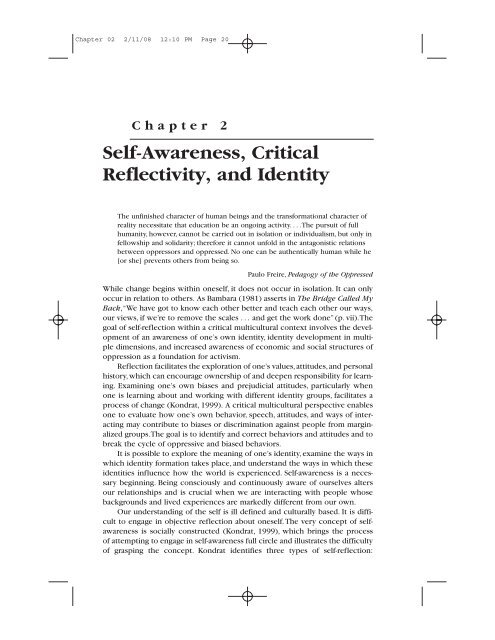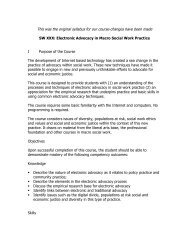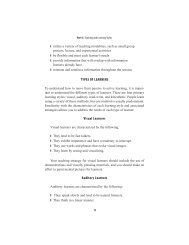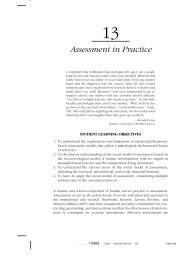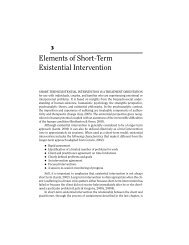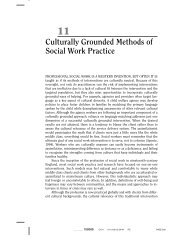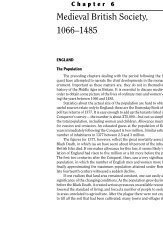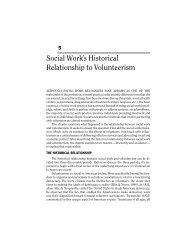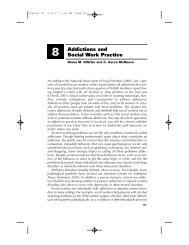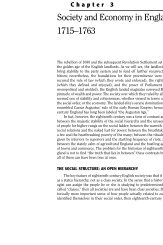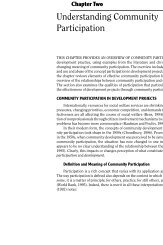Chapter 2 Self-Awareness, Critical Reflectivity, and ... - Lyceum Books
Chapter 2 Self-Awareness, Critical Reflectivity, and ... - Lyceum Books
Chapter 2 Self-Awareness, Critical Reflectivity, and ... - Lyceum Books
You also want an ePaper? Increase the reach of your titles
YUMPU automatically turns print PDFs into web optimized ePapers that Google loves.
<strong>Chapter</strong> 02 2/11/08 12:10 PM Page 20<br />
<strong>Chapter</strong> 2<br />
<strong>Self</strong>-<strong>Awareness</strong>, <strong>Critical</strong><br />
<strong>Reflectivity</strong>, <strong>and</strong> Identity<br />
The unfinished character of human beings <strong>and</strong> the transformational character of<br />
reality necessitate that education be an ongoing activity....The pursuit of full<br />
humanity, however, cannot be carried out in isolation or individualism, but only in<br />
fellowship <strong>and</strong> solidarity; therefore it cannot unfold in the antagonistic relations<br />
between oppressors <strong>and</strong> oppressed. No one can be authentically human while he<br />
[or she] prevents others from being so.<br />
Paulo Freire, Pedagogy of the Oppressed<br />
While change begins within oneself, it does not occur in isolation. It can only<br />
occur in relation to others. As Bambara (1981) asserts in The Bridge Called My<br />
Back,“We have got to know each other better <strong>and</strong> teach each other our ways,<br />
our views, if we’re to remove the scales . . . <strong>and</strong> get the work done” (p. vii).The<br />
goal of self-reflection within a critical multicultural context involves the development<br />
of an awareness of one’s own identity, identity development in multiple<br />
dimensions, <strong>and</strong> increased awareness of economic <strong>and</strong> social structures of<br />
oppression as a foundation for activism.<br />
Reflection facilitates the exploration of one’s values,attitudes,<strong>and</strong> personal<br />
history,which can encourage ownership of <strong>and</strong> deepen responsibility for learning.<br />
Examining one’s own biases <strong>and</strong> prejudicial attitudes, particularly when<br />
one is learning about <strong>and</strong> working with different identity groups, facilitates a<br />
process of change (Kondrat, 1999). A critical multicultural perspective enables<br />
one to evaluate how one’s own behavior, speech, attitudes, <strong>and</strong> ways of interacting<br />
may contribute to biases or discrimination against people from marginalized<br />
groups.The goal is to identify <strong>and</strong> correct behaviors <strong>and</strong> attitudes <strong>and</strong> to<br />
break the cycle of oppressive <strong>and</strong> biased behaviors.<br />
It is possible to explore the meaning of one’s identity, examine the ways in<br />
which identity formation takes place, <strong>and</strong> underst<strong>and</strong> the ways in which these<br />
identities influence how the world is experienced. <strong>Self</strong>-awareness is a necessary<br />
beginning. Being consciously <strong>and</strong> continuously aware of ourselves alters<br />
our relationships <strong>and</strong> is crucial when we are interacting with people whose<br />
backgrounds <strong>and</strong> lived experiences are markedly different from our own.<br />
Our underst<strong>and</strong>ing of the self is ill defined <strong>and</strong> culturally based. It is difficult<br />
to engage in objective reflection about oneself.The very concept of selfawareness<br />
is socially constructed (Kondrat, 1999), which brings the process<br />
of attempting to engage in self-awareness full circle <strong>and</strong> illustrates the difficulty<br />
of grasping the concept. Kondrat identifies three types of self-reflection:
<strong>Chapter</strong> 02 2/11/08 12:10 PM Page 21<br />
<strong>Self</strong>-<strong>Awareness</strong>, <strong>Critical</strong> <strong>Reflectivity</strong>, <strong>and</strong> Identity 21<br />
reflective self-awareness, reflexive self-awareness, <strong>and</strong> critical reflectivity.<br />
Through reflective self-awareness one examines oneself in order to become<br />
aware of personal biases <strong>and</strong> the interactive process of identity construction.<br />
Reflexive self-awareness is a process through which one becomes aware of how<br />
meaning is created through one’s interactions with others. <strong>Critical</strong> reflectivity<br />
allows one to acknowledge oneself as both affecting <strong>and</strong> being affected by society<br />
<strong>and</strong> requires analysis of social structures. <strong>Critical</strong> reflectivity allows one to<br />
move beyond reflective self-awareness <strong>and</strong> reflexive self-awareness to a deeper<br />
level of underst<strong>and</strong>ing of oneself <strong>and</strong> one’s assumptions, <strong>and</strong> how these interact<br />
with social structures (Kondrat, 1999).<br />
The exercise in self-awareness developed by Elaine Pinderhughes (1989)<br />
asks people to think about race by reflecting on their life experiences (see box<br />
2.1).This exercise facilitates a growth in self-awareness. It can help people recognize<br />
behaviors <strong>and</strong> attitudes that contribute to any “isms” (e.g., racism, sexism,<br />
heterosexism). Unfortunately, it can be difficult to recognize one’s own biases,<br />
though it may be easier to recognize biases in others. Failure to recognize<br />
personal biases or negative attitudes toward others results in resistance to owning<br />
the possibility that one may be racist,sexist,or heterosexist (Kondrat,1999).<br />
When a person examines her or his personal attitudes <strong>and</strong> behaviors in isolation<br />
from the larger social, political, <strong>and</strong> economic context, the structural barriers<br />
that impede the access to resources are not acknowledged. Neither the distortions<br />
of history nor the social construction of meaning is evaluated. This<br />
leads to racist acts <strong>and</strong> other oppressive practices. Individuals can fail to assess<br />
their own racist or biased thoughts <strong>and</strong> behaviors, as well as those of the community.<br />
Or they might acknowledge that biases do exist but feel that there is<br />
nothing they can do to change these situations (Kondrat, 1999).<br />
Box 2.1 <strong>Self</strong>-<strong>Awareness</strong> Exercise<br />
This assignment has two parts. First, respond to the questions<br />
below.Then, choose a family member or another significant person in<br />
your life who is either a generation older or younger than you. It is important<br />
that you do the self-interview first so that your interviewee’s responses<br />
do not influence your answers. If you wish to share your answers<br />
with the person you interview, do so after you’ve completed the<br />
interview to avoid influencing your interviewee.<br />
1. What is your ethnic or racial background? What has it meant<br />
to belong to this group?<br />
2. Where did you grow up <strong>and</strong> what other racial/ethnic groups<br />
resided there?<br />
3. What was your first experience with feeling different?<br />
4. Did your family see itself as similar to or different from other<br />
ethnic groups?<br />
5. What are the values of your racial/ethnic group?<br />
6. What is your earliest memory of race or color?
<strong>Chapter</strong> 02 2/11/08 12:10 PM Page 22<br />
22 <strong>Critical</strong> Multicultural Social Work<br />
7. What emotion did you experience?<br />
8. With whom did you discuss this experience?<br />
9. What are your feelings about being white or a person of color?<br />
10. For people who are white: How do you think people of color<br />
feel about their color identity?<br />
11. For people of color: How do you think people who are white<br />
feel about their color identity?<br />
12. How have you experienced a sense of power or lack of power<br />
in relation to your racial/ethnic identity, family, class identity,<br />
gender, sexual orientation, <strong>and</strong> professional identity?<br />
After transcribing the interviews, write a reflection paper about the interviews.<br />
Consider the following questions: How might your personal<br />
values, history, <strong>and</strong> experiences influence the way in which you view<br />
others? What are some of the similarities <strong>and</strong> differences you encountered<br />
between your answers <strong>and</strong> your interviewee’s answers? In what<br />
ways might your interviewee’s views influence your thinking? Has this<br />
exercise raised questions for you concerning your readiness to work<br />
with people from different cultures?<br />
Source: Adapted from Pinderhughes, E. (1989). Underst<strong>and</strong>ing race, ethnicity,<br />
<strong>and</strong> power: The key to efficacy in clinical practice. New York: Free Press.<br />
An approach that encompasses both oneself <strong>and</strong> the sociopolitical context<br />
breaks this gridlock.Advocates of critical reflectivity start with the supposition<br />
that all people <strong>and</strong> institutions somehow contribute to the oppressive behaviors<br />
<strong>and</strong> practices that perpetuate inequality (Kondrat, 1999).This suggests that<br />
one’s daily interactions with others, whether conscious or unconscious, intentional<br />
or not, have broad <strong>and</strong> profound ramifications regarding racism, sexism,<br />
heterosexism, <strong>and</strong> ableism. Because one cannot wholly escape societal influences,<br />
one’s conscious anti-racist convictions, attitudes, <strong>and</strong> behaviors do not<br />
exclude one from participation in the perpetuation of inequality. Racist <strong>and</strong><br />
other oppressive acts are often perceived as overt actions, but inaction can produce<br />
the same results.What we do not know or are not conscious of can have<br />
unintended negative consequences for marginalized people.<br />
When we consider the possibility that there may be alternative interpretations<br />
of reality,we allow ourselves to explore the significance <strong>and</strong> impact of our<br />
interactions with others.Assessing how we perceive <strong>and</strong> interact with people<br />
who are different from ourselves is a meaningful way to identify unconscious<br />
biases.The following questions reflect the spirit of critical reflectivity.<br />
1. What do I do on a day-to-day basis that might contribute to inequality?<br />
2. What have I learned about how to perceive or how to relate to members<br />
of my own group or other groups, <strong>and</strong> what is the source of that<br />
learning?
<strong>Chapter</strong> 02 2/11/08 12:10 PM Page 23<br />
<strong>Self</strong>-<strong>Awareness</strong>, <strong>Critical</strong> <strong>Reflectivity</strong>, <strong>and</strong> Identity 23<br />
3. What do I know about how to relate to <strong>and</strong> interpret the behavior of<br />
others who occupy social locations (i.e., class, gender, race/ethnicity,<br />
sexual orientation, ability, religion) that are similar to, as well as different<br />
from, my own?<br />
4. What have I learned about how to interpret the behavior of people<br />
whose race/ethnicity, sexual orientation, ability, or religion is different<br />
from my own? What if I add class <strong>and</strong> gender/sex to the equation?<br />
5. What do I know about my conscious intentions when I interact with a<br />
client who is African American, Latino/Latina, Native American, Asian<br />
American, biracial or multiracial, or European American; refugees <strong>and</strong><br />
other immigrants; people who are gay, lesbian, bisexual, transgender, or<br />
intersex; <strong>and</strong> people with disabilities?<br />
6. Why do the consequences or outcomes of my actions not fit with or<br />
match my good intentions? (Kondrat, 1999)<br />
These questions facilitate a process of reflection that allows for critical selfreflectivity.<br />
Box 2.2 provides an example of a situation in which this reflection<br />
was useful to a social work intern in her work.<br />
Box 2.2 Reflections of a Social Work Intern<br />
Carrie, a white social work intern in her mid-twenties, is completing<br />
her practicum in a community-based social service agency. She has<br />
been assigned several cases throughout the academic year. As she approaches<br />
her final two months of field work, she is asked to reflect on<br />
her experiences in preparation for the end-of-term field evaluation.Carrie<br />
was eager to start her internship <strong>and</strong> chose to work in an urban<br />
agency that had a diverse client population. Having been raised in a<br />
family that believed that all people should be treated equally, <strong>and</strong> having<br />
lived most of her life in a small rural all-white community, Carrie<br />
was looking forward to the challenges of an urban experience.<br />
Carrie’s agency is located in an active urban community that is<br />
home to a growing number of racial/ethnic groups. At this community<br />
service organization, clients can find a diverse range of services all<br />
under one roof.The rapid growth of the community, however, has required<br />
changes within the agency, which is now often short staffed.<br />
Although clients from various racial/ethnic groups are served, the<br />
agency staff is primarily composed of white middle-class women. Carrie<br />
looks to her colleagues <strong>and</strong> supervisor to underst<strong>and</strong> agency protocol<br />
in this rapidly changing environment.<br />
Carrie has demonstrated her willingness to actively engage in reflective<br />
practice through the use of supervision, journal writing, <strong>and</strong><br />
field seminar discussions. Her weekly meetings with her supervisor<br />
have been very task focused, <strong>and</strong> she has received positive feedback<br />
about her performance. While reviewing her cases thus far, however,
<strong>Chapter</strong> 02 2/11/08 12:10 PM Page 24<br />
24 <strong>Critical</strong> Multicultural Social Work<br />
Carrie <strong>and</strong> her supervisor noticed a pattern in some of her closed<br />
cases. Clients of other racial <strong>and</strong>/or ethnic groups have had less favorable<br />
outcomes than white clients. Carrie was concerned with this revelation.<br />
She is committed to the field of social work <strong>and</strong> believes in<br />
treating all people equally.<br />
Carrie reviewed her cases <strong>and</strong> asked herself Kondrat’s questions.<br />
As she evaluated her daily behavior, how she related to <strong>and</strong> interpreted<br />
the behavior of others, her intentions, <strong>and</strong> the consequences of her actions,<br />
she came to realize that in spite of her commitment to equal<br />
treatment, she inadvertently disregarded the history, culture, <strong>and</strong> value<br />
differences that significantly influence the way in which racial/ethnic<br />
identity affects an individual’s experience of the world.<br />
Reflection<br />
Engaging in critical reflectivity offers an opportunity for the assessment of personal<br />
beliefs, intentions, <strong>and</strong> attitudes.The process highlights areas in which assumptions<br />
<strong>and</strong> interactions between oneself <strong>and</strong> others result in behaviors that<br />
perpetuate the marginalization of people who have been oppressed. This<br />
process reveals how power <strong>and</strong> privilege are understood or misunderstood,<strong>and</strong><br />
how assumptions make a difference in determining whether interactions are<br />
productive, hurtful, or destructive. Categorical differences such as class, socioeconomic<br />
position, ability, sexual orientation, gender, <strong>and</strong> sex influence the interactions<br />
between members of privileged groups <strong>and</strong> people who are from historically<br />
oppressed populations. <strong>Critical</strong> reflectivity allows people to begin to<br />
underst<strong>and</strong> how their experience of themselves is embedded in their interactions<br />
with others <strong>and</strong> how shared meanings are created (Kondrat, 1999). The<br />
focus is on examining the ways things can be changed, not on what could or<br />
should have happened. Moving beyond guilt, shame, or anger to critical reflection<br />
facilitates growth <strong>and</strong> the development of a new social consciousness<br />
(Schmitz et al., 2001). Misinformation that was received in the past can be corrected,<br />
<strong>and</strong> behavior modified in the future.<br />
Underst<strong>and</strong>ing oneself in context allows one to search for new explanations<br />
for one’s behavior <strong>and</strong> intentions (Schmitz et al., 2001). In this process,<br />
personal biases <strong>and</strong> cultural stereotypes, societal prejudices <strong>and</strong> oppression,<br />
<strong>and</strong> the experiences of all racial/ethnic groups in modern society are examined.<br />
It is within the context of our own experiences, relationships, family, community,<br />
<strong>and</strong> culture that we interpret our daily interactions. Underst<strong>and</strong>ing ourselves<br />
involves examining the norms, values, <strong>and</strong> skills arising from our own<br />
racial/ethnic, gender, socioeconomic, ability, <strong>and</strong> sexual orientation history <strong>and</strong><br />
identification.<br />
As we engage in the process,we come to recognize the disparities in power<br />
<strong>and</strong> authority between ourselves <strong>and</strong> others, <strong>and</strong> we begin to underst<strong>and</strong> that
<strong>Chapter</strong> 02 2/11/08 12:10 PM Page 25<br />
<strong>Self</strong>-<strong>Awareness</strong>, <strong>Critical</strong> <strong>Reflectivity</strong>, <strong>and</strong> Identity 25<br />
our actions may have unintended consequences for others (Kondrat, 1999). Individuals<br />
who are white may recognize that they are members of a group that<br />
has historically oppressed people from other racial/ethnic groups,<strong>and</strong> that they<br />
are perceived as such by others. Collective knowledge of race relations <strong>and</strong> personal<br />
experience with racism may make people of color reticent to accept the<br />
actions of white individuals <strong>and</strong> groups. Similarly, white individuals <strong>and</strong> groups<br />
may feel the guilt <strong>and</strong> shame of racism, which can interfere with their interactions<br />
with others. Likewise, interactions between members of different populations<br />
of color are also influenced by assumptions, biases, <strong>and</strong> prejudices.<br />
Through dialogue it is possible to build bridges across difference.<br />
One of the hidden phenomena of membership in a privileged group is the<br />
assumption of normality, according to which others are not normal. Assumptions<br />
are too often built on mythology <strong>and</strong> assumptions of one’s own normality.<br />
For instance, the assumption that growing up in a multiracial family or a family<br />
with lesbian or gay parents can harm children is not based on data. People’s interactions<br />
with others are influenced by myths like these.The consequences are<br />
destructive in social workers’ work with children <strong>and</strong> families.With guidance,<br />
the experience of difference can lead to the development not only of a strong<br />
sense of self but also empathy, compassion, <strong>and</strong> underst<strong>and</strong>ing. Unexamined belief<br />
systems <strong>and</strong> ways of knowing are not adequate preparation for engaging in<br />
relationships in a multicultural environment. Racism, heterosexism <strong>and</strong> homophobia,sexism,transphobia,<strong>and</strong><br />
ableism are pervasive in our society;even a person<br />
who sees her- or himself as unprejudiced can be guilty of these prejudices<br />
(Tatum, 1994).This realization can cause a broad range of emotions—including<br />
frustration, upset, shame, fault, <strong>and</strong> guilt (Schmitz et al., 2001). These uncomfortable<br />
feelings can create barriers to learning.Learning to recognize privileges<br />
that result from oppressive systems creates opportunities for creating change.<br />
Examination of the learning process illuminates ways in which belief systems<br />
are shaped (see figure 2.1). We enter this world lacking assumptions.<br />
Through socialization by family, friends, <strong>and</strong> other people we respect <strong>and</strong> trust,<br />
we learn stereotypes, misinformation, myths, <strong>and</strong> partial histories that glorify<br />
some, vilify others, <strong>and</strong> erase people <strong>and</strong> events by making no mention of them<br />
at all. Misinformation acquired through early learning is reinforced by institutional<br />
<strong>and</strong> cultural structures such as the media, schools, religion, <strong>and</strong> governmental<br />
<strong>and</strong> legal systems, as well as traditions <strong>and</strong> customs. At each stage of<br />
learning we consciously, or unconsciously, accept what we have been taught.<br />
These truths, as we come to know them, shape how we see ourselves <strong>and</strong> how<br />
we view others. Our self-identity can be bolstered or deflated depending on the<br />
social strata we occupy.The sense of ourselves as racist, sexist, homophobic beings<br />
brings up a variety of emotions ranging from a false sense of superiority to<br />
a false sense of inferiority. Once new learning is internalized, the potential for<br />
making informed choices exists.We can decide to pass on the misinformation<br />
<strong>and</strong> act in ways that continue to marginalize people, or we can break the cycle<br />
<strong>and</strong> become allies with marginalized groups by acting responsibly.
<strong>Chapter</strong> 02 2/11/08 12:10 PM Page 26<br />
26 <strong>Critical</strong> Multicultural Social Work<br />
FIGURE 2.1 Learning <strong>and</strong> Unlearning Assumptions of Hierarchical Social Orders<br />
We continue<br />
oppressive<br />
practices.<br />
We are empty of<br />
assumptions.<br />
We learn misinformation, myths,<br />
or nothing at all from family,<br />
friends, <strong>and</strong> others we respect<br />
<strong>and</strong> trust.<br />
Misinformation <strong>and</strong> myths are<br />
reinforced through institutional<br />
<strong>and</strong> cultural structures.<br />
We consciously or unconsciously accept what<br />
we are taught.<br />
We become allies.<br />
Identity Development<br />
Identity development models are one tool for exploring similarities <strong>and</strong> differences<br />
between people of different racial/ethnic backgrounds, gender <strong>and</strong> sexual<br />
orientation, <strong>and</strong> ability status.There are also models that explore the development<br />
of people’s identities in terms of gender, sex, sexual orientation, <strong>and</strong><br />
ability status.<br />
Race per se does not determine the quality of interactions between member<br />
of different racial groups. Racial identity development is a more salient fac-
<strong>Chapter</strong> 02 2/11/08 12:10 PM Page 27<br />
<strong>Self</strong>-<strong>Awareness</strong>, <strong>Critical</strong> <strong>Reflectivity</strong>, <strong>and</strong> Identity 27<br />
tor (Carter, 1993). Racial identity development is not just something people<br />
who are white need to underst<strong>and</strong>; populations that have historically been oppressed<br />
<strong>and</strong> marginalized because of their race must underst<strong>and</strong> the process<br />
as well.Helms’s (1993a) study of racial dyads highlights important implications<br />
for all people’s underst<strong>and</strong>ing of racial identity development. Cognitive, affective,<br />
<strong>and</strong> behavioral issues are likely to influence different mechanisms that<br />
people use for coping with racial issues. The overlap between models of<br />
African American identity development <strong>and</strong> the model of white racial identity<br />
development further elucidates issues of identity, race, <strong>and</strong> racism. Tatum<br />
(2003) points out that all groups of color in the United States face issues regarding<br />
racism <strong>and</strong> as a result grapple with many of the identity development<br />
issues discussed by Helms (1993c), such as balancing the issues of assimilation<br />
into the dominate culture with the need to retain identification with one’s<br />
own culture <strong>and</strong> community.<br />
Racial identity development is neither static nor linear. Not everyone starts<br />
at the same place, nor does everyone progress in a step-by-step manner. The<br />
manner in which one’s racial identity is integrated into her or his personality<br />
depends on several sociocultural factors, such as parents, family, peers, schools,<br />
religious organizations, <strong>and</strong> the media; systemic factors, such as socioeconomic<br />
class,discrimination,<strong>and</strong> quality of interracial interactions;<strong>and</strong> physical <strong>and</strong> personal<br />
attributes (Helms, 1993a).<br />
African American Racial Identity Model<br />
Theories of visible racial/ethnic identity in populations of color have been<br />
a topic of interest for several decades. William E. Cross <strong>and</strong> Janet Helms are<br />
among the leaders in this field of study. The model of racial identity development<br />
for people who are African American was first introduced by Cross (1978,<br />
1980, 1991) <strong>and</strong> was later exp<strong>and</strong>ed by Helms (1984, 1993c, 1994).This model<br />
outlines the path that people who are African American may take in developing<br />
a healthy racial identity. Helms’s (1993c) amended model, which focuses on<br />
one’s worldview, delineates the five stages of racial identity formation: preencounter,<br />
encounter, immersion/emersion, internalization, <strong>and</strong> internalization/<br />
commitment.<br />
During the pre-encounter stage, people who are African American idealize<br />
the worldview of the dominant white culture <strong>and</strong> denigrate blackness <strong>and</strong> black<br />
culture. It is assumed that people who are white hold their advantaged status<br />
because of their extraordinary efforts, <strong>and</strong> that people who are African American<br />
are disadvantaged because they have not exercised enough effort.The person<br />
denies her or his racial identity <strong>and</strong> identifies with people who are white.<br />
During this stage the person attributes her or his success or failure to how well<br />
she or he imitates the traits associated with whiteness (Helms, 1993b).<br />
During the encounter stage, the person becomes aware that race is the<br />
delineator that determines or influences one’s life options. A single event or an
<strong>Chapter</strong> 02 2/11/08 12:10 PM Page 28<br />
28 <strong>Critical</strong> Multicultural Social Work<br />
accumulation of events may lead to the realization that the Eurocentric worldview<br />
is no longer viable, <strong>and</strong> that another identity must be found. During the<br />
struggle to realize a new identity, she or he vacillates between shedding the<br />
pre-encounter identity <strong>and</strong> assuming a not yet clearly articulated African American<br />
identity.This phase is wrought with mixed emotions, ranging from confusion<br />
in the earlier stages to euphoria experienced at a later stage.<br />
The immersion/emersion stage consists of two parts.First is the acceptance<br />
of a positive authentic African American identity <strong>and</strong> a black or Afrocentric<br />
worldview. The individual adopts an African American identity <strong>and</strong> ab<strong>and</strong>ons<br />
her or his previously constructed personal identity. The person might also<br />
overtly express a blackness that conforms to white stereotypes of blackness.<br />
During this stage African Americans may express anger toward people who are<br />
white,because they see them as the oppressors,<strong>and</strong> toward other African Americans<br />
who don’t share their new perception of themselves.The individual experiences<br />
emotional ups <strong>and</strong> downs in trying to come to terms with a new<br />
identity <strong>and</strong> worldview. Immersion is a process of self-exploration, while emersion<br />
is a process of joining the community of identity to exp<strong>and</strong> one’s development.<br />
Emersion offers the possibility of escape from immersion. During<br />
emersion the person withdraws into a supportive African American community<br />
<strong>and</strong> engages in cathartic experiences. During this stage a person may engage in<br />
a range of social or political activities that allows exploration of African American<br />
<strong>and</strong> African cultural issues.The emersion into African American culture allows<br />
the person to develop a nonstereotypical Afro-American worldview.<br />
The internalization stage marks the point at which one is able to positively<br />
internalize the unique elements of her or his personal identity blended with her<br />
or his African American identity.The person can now face the world from a position<br />
of strength <strong>and</strong> identifies with the African American group.The person rejects<br />
racism <strong>and</strong> other forms of oppression but can have positive relationships<br />
with supportive people who are white. Finally, internalization/commitment describes<br />
the continuation <strong>and</strong> nurturing of one’s positive African American identity<br />
<strong>and</strong> involvement in social <strong>and</strong> civic activities that combat all forms of racism<br />
<strong>and</strong> oppression.<br />
White Racial Identity Development<br />
Far <strong>and</strong> away the most troublesome consequence of race obliviousness for<br />
many people is the failure to recognize the privileges our society confers on<br />
them because they have white skin.The privilege of white skin is a birthright,<br />
a set of advantages one receives simply by being born with features that society<br />
values (Dalton, 2002).<br />
White people who fail to see themselves as racialized (that is, they tend not<br />
to think of themselves in racial terms) also fail to see the ways in which they<br />
are privileged. Peggy McIntosh (1990) wrote a l<strong>and</strong>mark article about her own<br />
examination of her white privilege, in which she identified the many ways in
<strong>Chapter</strong> 02 2/11/08 12:10 PM Page 29<br />
<strong>Self</strong>-<strong>Awareness</strong>, <strong>Critical</strong> <strong>Reflectivity</strong>, <strong>and</strong> Identity 29<br />
which white people experience privilege. People who are white know that<br />
they are white, but this is often translated as being just American.They do not<br />
have any experience underst<strong>and</strong>ing race <strong>and</strong> how it shapes our lives.They typically<br />
don’t think about their whiteness, nor do they think about the privilege<br />
bestowed on them because of their race.<br />
This inability or unwillingness to think of oneself in racial terms has decidedly<br />
negative consequences. For one thing, it produces huge blind spots. It<br />
leaves people who are white baffled by the amount of energy many African<br />
Americans <strong>and</strong> other people of color pour into questions of racial identity. It<br />
makes it difficult for white people to underst<strong>and</strong> why many people of color<br />
have a sense of group consciousness that influences the choices they make as<br />
individuals. It blinds them to the fact that their lives are shaped by race just as<br />
much as the lives of people of color. How white people view life’s possibilities,<br />
whom they regard as heroes,the extent to which they feel the country is theirs,<br />
<strong>and</strong> the extent to which that belief is reinforced by society—all of this, <strong>and</strong><br />
more, is a function of race.The internalized assumption of normality prevents<br />
them from imagining other possibilities.<br />
Skin color is a complex social indicator that promotes differential power<br />
<strong>and</strong> privilege between people who are seen as white <strong>and</strong> people of color (Pinderhughes,<br />
1989). One’s perception of reality is seldom questioned, except<br />
when one stumbles upon others who are different <strong>and</strong> have opposing worldviews.<br />
This conflict offers people who are white the opportunity to develop<br />
knowledge <strong>and</strong> awareness of themselves as racial beings. People who are white<br />
are generally unaware of ways to develop a racial identity <strong>and</strong> have few opportunities<br />
to underst<strong>and</strong> what it means to be white until they choose to embrace<br />
nonracist perspectives (Carter, 1995).White racial identity theory explains the<br />
developmental process that people who are white need to engage in to gain a<br />
better underst<strong>and</strong>ing of themselves <strong>and</strong> the environments in which they live.<br />
Exercises such as McIntosh’s (1990) “White Privilege: Unpacking the Invisible<br />
Knapsack,” a list of advantages that people with white skin experience in their<br />
daily lives <strong>and</strong> take for granted, can help individuals identify the ways in which<br />
they experience white privilege.These benefits range from being confident that<br />
one will not be discriminated against because of skin color in a job interview<br />
or when one tries to rent an apartment to seeing people of one’s own race represented<br />
on television. This exercise (which is available online) can advance<br />
racial identity awareness, but her work also has implications for underst<strong>and</strong>ing<br />
how various marginalized groups are disadvantaged. If one substitutes “people<br />
of my own sexual orientation” or “others with a disability” for “people of my<br />
race” <strong>and</strong> “people of my racial group” in most of the situations described by<br />
McIntosh (for example,“I can, if I wish, arrange to be in the company of people<br />
of my race most of the time” or “I am never asked to speak for all the people of<br />
my racial group”),then one can see how unearned privilege benefits those who<br />
are heterosexual or able-bodied <strong>and</strong> disadvantages people who are gay, lesbian,<br />
bisexual, or people who have a disability.
<strong>Chapter</strong> 02 2/11/08 12:10 PM Page 30<br />
30 <strong>Critical</strong> Multicultural Social Work<br />
Helms’s (1993d) white racial identity development theory, called the ab<strong>and</strong>onment<br />
of racism, runs parallel to the black racial identity development model<br />
<strong>and</strong> consists of six stages that occur in two phases (see figure 2.2).The process<br />
begins with the ab<strong>and</strong>onment-of-racism phase, which has three stages: contact,<br />
disintegration, <strong>and</strong> reintegration. This is followed by the defining-a-nonracistwhite-identity<br />
phase, which also involves three stages: pseudo-independence,<br />
immersion/emersion, <strong>and</strong> autonomy.<br />
In the contact stage, people who are white develop a vague awareness of<br />
the presence of people of color. During this stage, people who are white may<br />
approach people of color with a tentative curiosity <strong>and</strong> may have only a vague<br />
or superficial awareness of their own whiteness. At this stage they still use their<br />
own whiteness as the norm against which they compare people of color, unaware<br />
that there are multiple ways to evaluate others.They pass judgment without<br />
underst<strong>and</strong>ing that whiteness is the norm against which they evaluate all<br />
others in terms of physical appearance, customs, values, behavior, <strong>and</strong> the like.<br />
Their interactions with people of color in social <strong>and</strong> occupational settings are<br />
limited, which means they have little opportunity to test their assumptions<br />
about people of color.<br />
During the disintegration stage, whites start to develop a consciousness of<br />
whiteness.They begin what is sometimes a painful process of questioning what<br />
they have been taught <strong>and</strong> what they believe to be true. It is at this point that<br />
people who are white recognize that there are inequalities based on race <strong>and</strong><br />
that social structures perpetuate oppression.They realize as well that their assumptions<br />
about whiteness <strong>and</strong> people of color are incorrect. Accepting that<br />
one is misinformed may also cause one to call into question one’s ability to interact<br />
with people of color.<br />
FIGURE 2.2 Stages <strong>and</strong> Phases of White Racial Identity Development<br />
Phase 1 Ab<strong>and</strong>onment of Racism<br />
Contact<br />
Pseudoindependent<br />
Disintegration Reintegration<br />
Phase 2 Defining a Nonracist White Identity<br />
Immersion/Emersion Autonomy<br />
Source: Helms, J. (1993c).Toward a model of white racial identity development. In J. Helms (Ed.),<br />
Black <strong>and</strong> white racial identity. Copyright © 1993 by Janet E. Helms. Reproduced with permission<br />
of Greenwood Publishing Group, Inc.,Westport, CT.
<strong>Chapter</strong> 02 2/11/08 12:10 PM Page 31<br />
<strong>Self</strong>-<strong>Awareness</strong>, <strong>Critical</strong> <strong>Reflectivity</strong>, <strong>and</strong> Identity 31<br />
During reintegration, the third stage of phase 1, people have acknowledged<br />
their white identity but assume that the social structures that privilege them<br />
<strong>and</strong> disadvantage others are part of a natural order. During this stage, people selectively<br />
process or reinterpret the world around them to align with the social<br />
mores that encourage stereotypes of people.They often minimize or deny similarities<br />
that they observe between people who are white <strong>and</strong> people of color.<br />
During pseudo-independence, the first stage of the second phase, the individual<br />
begins the formation of a positive white identity, engaging in an intellectual<br />
process in an effort to make sense of what she or he has learned.Assumptions,<br />
including notions of superiority <strong>and</strong> inferiority based on race, are<br />
questioned in earnest.The person begins to acknowledge that she or he has a<br />
responsibility to help dismantle the system of oppression of people of color.Yet<br />
people at this stage may still behave in ways that inadvertently maintain the status<br />
quo.They may now see people of color as victims but may also believe that<br />
the solution to the problem is to help people of color adopt the culture of the<br />
white dominant society.They do not yet see racial differences as viable alternative<br />
ways of being.They still measure all people against the white ideal. During<br />
this stage, the motives of individuals who are earnest about developing a positive<br />
white racial identity may be questioned by the racial groups they are trying<br />
to champion <strong>and</strong> may be viewed with suspicion by family members or other<br />
people they know who are white.Those who are encouraged to continue the<br />
campaign against race-based social injustice are well on their way to developing<br />
a racial identity that no longer privileges whiteness <strong>and</strong> marginalizes people<br />
of color.<br />
Immersion/emersion is the period during which people develop a strong<br />
commitment to the development of a positive white racial identity, <strong>and</strong> to replacing<br />
myths <strong>and</strong> stereotypes about whiteness <strong>and</strong> people of color with accurate<br />
information. The questions that are asked at this stage are “Who am I<br />
racially?”“Who do I want to be?” <strong>and</strong> “Who are you really?” People often facilitate<br />
this journey by reading about others who are white who have engaged in<br />
racial identity struggles or by participating in white consciousness-raising<br />
groups that are committed to addressing racial injustice. At this stage, individuals<br />
no longer see people of color as needing to be fixed.They fully accept the<br />
need for people who are white to play an integral role in the change process.<br />
Autonomy, the final stage, describes the internalization of a new definition<br />
of whiteness <strong>and</strong> a commitment to nurture this identity.The person is now committed<br />
to eliminating oppressive behaviors; she or he no longer vilifies or pays<br />
tribute to others based on their group membership. While developing an autonomous<br />
racial identity, the person also seeks out opportunities to engage<br />
with members of other racial <strong>and</strong> cultural groups.This final stage of white racial<br />
identity does not represent the end of racial identity development, but a new<br />
beginning that must be nurtured, encouraged, <strong>and</strong> respected.This stage marks<br />
the individual’s acceptance that this is an ongoing process requiring openness<br />
to new information <strong>and</strong> different worldviews.Tatum (1994) describes the final
<strong>Chapter</strong> 02 2/11/08 12:10 PM Page 32<br />
32 <strong>Critical</strong> Multicultural Social Work<br />
stage as much like a spiral staircase that allows the individual to revisit previous<br />
stages before moving forward.As in the final stage in African American identity<br />
development, the person no longer feels the need to pass judgment on others<br />
based on group membership.<br />
Alternative Models of Identity Development<br />
Helms’s models of racial identity development for African Americans <strong>and</strong><br />
whites are conceptualized in stages that focus on actions rather than outcomes.<br />
The stages describe a series of experiences that force us to ask who we are <strong>and</strong><br />
to question our identity. Since the appearance of racial identity development<br />
models in the literature,the concepts described in these models have been used<br />
to describe the experiences of other cultural groups, which suggests comparable<br />
processes <strong>and</strong> experiences among marginalized groups (Sue, Carter, Casas,<br />
Fouas, Ivey, Jensen, et al., 1998).The experiences of people who are from non-<br />
Western cultures may be different <strong>and</strong> the process of identity development that<br />
they go through may be different as well, <strong>and</strong> some people have argued that<br />
Helms’s model does not represent their own experiences. Sue <strong>and</strong> Sue (1993),<br />
for instance, present a model of identity development for Asian Americans that<br />
focuses on historical, familial, <strong>and</strong> cultural issues. This does not mean that<br />
Helms’s model should be discarded. In fact, Tatum (2003), in support of the<br />
Helms model, identifies some issues regarding identity development in racist<br />
environments that affect all communities of color. Stage models <strong>and</strong> other models<br />
for underst<strong>and</strong>ing different ways of being <strong>and</strong> knowing can be used in parallel<br />
with each other, as each is a legitimate way of explaining the identity development<br />
process. Examining other models minimizes hierarchal ordering <strong>and</strong><br />
allows one to embrace <strong>and</strong> honor all ways of knowing.<br />
Wilson (1996) believes that indigenous Americans’ embrace of the interconnectedness<br />
between the person <strong>and</strong> her or his multiple environments is a<br />
useful alternative to the singularly focused racial/ethnic identity model proposed<br />
by Helms, which does not account for simultaneous experiences of difference.<br />
Intersecting <strong>and</strong> simultaneous oppressions must be assessed, as they<br />
change the context <strong>and</strong> content of an individual’s experience <strong>and</strong> may also<br />
change how one’s identity is understood.<br />
The experiences of Native Americans are often conveyed through storytelling,<br />
a method that has not been commonly used in Western research. Storytelling<br />
<strong>and</strong> narratives, however, are an integral part of indigenous knowledge<br />
building <strong>and</strong> research. Stories can be powerful <strong>and</strong> can contribute to a collective<br />
story in which the experiences of every indigenous person can be heard<br />
(Smith, 1999). Horse (2001) uses story <strong>and</strong> history to present a model of identity<br />
development for Native Americans. He presents a model that crosses the individual<br />
<strong>and</strong> group, incorporating history, language <strong>and</strong> culture, traditions, <strong>and</strong><br />
spirituality. In the end, personal <strong>and</strong> cultural identities remain intertwined.
<strong>Chapter</strong> 02 2/11/08 12:10 PM Page 33<br />
<strong>Self</strong>-<strong>Awareness</strong>, <strong>Critical</strong> <strong>Reflectivity</strong>, <strong>and</strong> Identity 33<br />
Like Native Americans, Asian Americans may experience different identity<br />
development pathways. Few models of identity development have been constructed<br />
with an Asian identity development in mind (Yeh & Huang, 1996).<br />
Sodowsky, Kwan, <strong>and</strong> Pannu (1995) proposed a model of Asian ethnic identity<br />
that considers the complex interactions between the individual <strong>and</strong> the context<br />
in which she or he is placed.This model is nonlinear <strong>and</strong> bidirectional, which<br />
means that it views an individual’s ethnic identity orientation as situational <strong>and</strong><br />
changing over time (Chae, 2001/2002).The extent <strong>and</strong> degree of one’s acculturation<br />
into the dominant cultural can have a direct influence on one’s ethnic<br />
identity.The nonlinear ethnic identity process “does not arise out of labiality or<br />
stability, rather it arises out of the ethnic individual’s adaptive principles of flexibility<br />
<strong>and</strong> openness to possibilities” (Sodowsky et al., 1995, p. 145).<br />
Sue <strong>and</strong> Sue (1993) examine the impact of Asian cultural values <strong>and</strong> cultural<br />
<strong>and</strong> legal racism on the identity development of Asian Americans. In Asian cultures,<br />
loyalty to one’s family <strong>and</strong> community has a higher value than autonomy<br />
<strong>and</strong> independence. Restraint of emotion is valued. These values conflict with<br />
many of the dominant culture values in the United States. Kim (2001) looks at<br />
how Asian Americans resolve these conflicts. She presents an Asian American<br />
identity development theory that consists of five stages: ethnic awareness,<br />
white identification, awakening to social political consciousness, redirection to<br />
an Asian American consciousness, <strong>and</strong> incorporation of a positive identity as<br />
Asian American. Similar to Helms’s model of racial identity development for<br />
African Americans, Kim’s theory involves a movement from idealization of<br />
whiteness to an increased appreciation of one’s own culture <strong>and</strong> an increased<br />
social <strong>and</strong> political consciousness.<br />
Models of identity development for Latinos <strong>and</strong> Latinas are complex since<br />
commonly used racial categories do not fit, as a person can be both Latino/<br />
Latina <strong>and</strong> a member of any of the other racial groups (Ferdman & Gallegos,<br />
2001). The complexity is intensified by the diversity of cultures <strong>and</strong> cultural<br />
identification. Ferdman <strong>and</strong> Gallegos (2001) identify five starting points for<br />
Latino/Latina identity development that are linked to self-identification as a<br />
Latino/Latina: Latin-integrated, Latino-identified, subgroup-identified, Latino as<br />
other, undifferentiated/denial, <strong>and</strong> white-identified.Torres <strong>and</strong> Baxter (2004) explore<br />
models of identity development for Latino <strong>and</strong> Latina college students<br />
with a focus on the impact of education on image development. They have<br />
found that exposure to a learning environment in which individuals can explore<br />
their ethnic/cultural environment <strong>and</strong> reconstruct their view of the world<br />
allows them to appreciate its complexity. This has a positive effect on identity<br />
development. Models of identity development for multiracial people are growing<br />
in complexity as people refuse to accept simplistic categorization. Kich<br />
(1992) <strong>and</strong> Poston (1990) have developed stage models of multiracial identity<br />
development; however, these models have been criticized as inadequate for encompassing<br />
the complexities of multiracial people (Wijeyesinghe, 2001). The
<strong>Chapter</strong> 02 2/11/08 12:10 PM Page 34<br />
34 <strong>Critical</strong> Multicultural Social Work<br />
factor model of multiracial identity considers eight factors that affect the<br />
choices of multiracial people: racial ancestry, cultural attachment, early experience<br />
<strong>and</strong> socialization, political awareness <strong>and</strong> orientation, spirituality, other<br />
social identities, social <strong>and</strong> historical context, <strong>and</strong> physical appearance (Wijeyesinghe,<br />
2001).<br />
Models exploring gender <strong>and</strong> sexual orientation identity development<br />
both overlap <strong>and</strong> differ.The development of gender roles <strong>and</strong> gender identity<br />
is commonly contested <strong>and</strong> open to debate. The role of biology in gender is<br />
only vaguely understood. Current research with transgender <strong>and</strong> intersex individuals<br />
both clarifies <strong>and</strong> clouds our knowledge of gender <strong>and</strong> gender identity.<br />
As we come to underst<strong>and</strong> transgender identity, it has become obvious that linear<br />
models cannot explain all paths to identity development (Bilodeau & Renn,<br />
2005).What is clear is that if there are biological components to the development<br />
of gender, they do little more than establish predispositions <strong>and</strong> tendencies.“Gender,<br />
like race, does become a social construction when it is treated as<br />
a categorical, fixed difference <strong>and</strong> then used to deny opportunity <strong>and</strong> equality<br />
to women” (Healey, 2003, p. 24). In exploring the relationship between feminist<br />
identity development <strong>and</strong> gender roles <strong>and</strong> well-being, Saunders <strong>and</strong><br />
Kashubeck-West (2006) have found that feminist identity correlates positively<br />
with psychological well-being. Downing <strong>and</strong> Roush (1985) present a model of<br />
feminist identity development derived from Cross’s model of racial identity development.<br />
Moradi (2005), who has examined the literature on womanist identity<br />
development, proposes the womanist identity development model as one<br />
that facilitates the simultaneous exploration of gender, race, <strong>and</strong> ethnicity.The<br />
little research that has been done shows correlations between feminist <strong>and</strong><br />
racial identity development. Likewise, Hoffman (2006) found correlations between<br />
gender <strong>and</strong> ethnic identity <strong>and</strong> self-acceptance.<br />
Many of the gender identity <strong>and</strong> sexual orientation developmental models<br />
are linear, though recent research incorporates knowledge development in the<br />
biological arena. Hunter (2005) thoroughly reviews the professional literature<br />
on the development of lesbian, gay, bisexual, <strong>and</strong> transgender identities. Most<br />
models of lesbian, gay, bisexual, <strong>and</strong> transgender identity are stage models that<br />
describe a linear progression across stages.The models are dated <strong>and</strong> simplistic<br />
in many respects (Hunter, 2005).While many look at these characteristics in<br />
isolation, some are more holistic, taking into consideration the impact of race<br />
<strong>and</strong> ethnicity on sexual orientation identity (Bilodeau & Renn, 2005). Parks,<br />
Hughes, <strong>and</strong> Matthews (2004), who explored racial <strong>and</strong> ethnic differences<br />
within sexual orientation, found support for a model of development in which<br />
timing <strong>and</strong> spacing of the phases are not rigid <strong>and</strong> fixed. They found that<br />
African American women <strong>and</strong> Latinas experienced similar processes, while<br />
white women were older when they first decided to explore their sexual orientation,<br />
faster in making decisions about their orientation, <strong>and</strong> quicker to disclose<br />
to others. White lesbians were more likely than lesbians of color, who<br />
must integrate their development as women of color with their sexual orientation<br />
development, to disclose their sexual orientation to people outside their
<strong>Chapter</strong> 02 2/11/08 12:10 PM Page 35<br />
<strong>Self</strong>-<strong>Awareness</strong>, <strong>Critical</strong> <strong>Reflectivity</strong>, <strong>and</strong> Identity 35<br />
families. Parks, Hughes, <strong>and</strong> Matthews hypothesize that their development as<br />
members of one historically oppressed group may help prepare lesbians of<br />
color for developing a healthy identity as members of a group that is oppressed<br />
because of sexual orientation; white women do not have that experience upon<br />
which to draw. Cramer <strong>and</strong> Gilson (1999) have found similarities between the<br />
identity development models for lesbian, gay, <strong>and</strong> bisexual individuals <strong>and</strong> for<br />
individuals with disabilities.They propose the use of a fluid model that recognizes<br />
the biopsychosocial-cultural context <strong>and</strong> the impact of language <strong>and</strong> multiple<br />
identities.<br />
Finally, Chestang’s (1972, 1984) theory on character development in a hostile<br />
environment focuses on the impact of social injustice <strong>and</strong> social inequality<br />
on personal <strong>and</strong> racial identity development. The struggle against abuse, forbearance,<br />
<strong>and</strong> the need to persevere affect the development of racial identity<br />
<strong>and</strong> group identification.According to Chestang’s theory of the depreciated or<br />
transcendent character, the combined impact of social injustice <strong>and</strong> inconsistency<br />
results in a feeling of personal impotence <strong>and</strong> inadequacy. Although all<br />
individuals who have been oppressed have developed both a depreciated character<br />
<strong>and</strong> a transcendent character, one becomes dominant. The depreciated<br />
character generally accepts what is <strong>and</strong> does not seek change;she or he accepts<br />
<strong>and</strong> navigates the oppressive system. She or he assimilates. On the other h<strong>and</strong>,<br />
the transcendent character forces change,finding innovative ways to change society’s<br />
inconsistencies while advocating social justice <strong>and</strong> empowerment. Hope<br />
<strong>and</strong> optimism become the driving force to develop an equitable system for all.<br />
Transcendent characters are change agents.<br />
Models for underst<strong>and</strong>ing identity development are useful tools because<br />
they provide a framework <strong>and</strong> structure that can help us formulate questions<br />
about who we are in relation to our interactions with others. Using these<br />
frameworks as blueprints, however, can lead to stereotyping <strong>and</strong> essentializing.<br />
Using models as the sole mechanism for underst<strong>and</strong>ing complex behaviors<br />
can cause one to disregard the complex interactions that can take place between<br />
different characteristics such as race/ethnicity, sex <strong>and</strong> gender, <strong>and</strong> sexual<br />
orientation.<br />
Multidimensional Identity Development<br />
Models of identity development are often unidimensional <strong>and</strong> therefore fail to<br />
acknowledge the interactions that occur between race, ethnicity, gender identity,<br />
sexual orientation, <strong>and</strong> ability. Consequently, they often do not validate<br />
multiple layers of oppression (<strong>and</strong> privilege). Privilege may go unrecognized,<br />
regardless of its source, <strong>and</strong> those with privilege may continue to oppress others.<br />
For instance, heterosexuals <strong>and</strong> able-bodied people, regardless of class,<br />
race, <strong>and</strong> gender, may perpetrate or reinforce oppressive <strong>and</strong> biased acts<br />
against those who are lesbian, gay, bisexual, transgender, or intersex <strong>and</strong> people<br />
with disabilities. Each individual in a multicultural society must be attuned<br />
to her or his own attitudes, beliefs, <strong>and</strong> actions.Table 2.1 shows a stage model
<strong>Chapter</strong> 02 2/11/08 12:10 PM Page 36<br />
36 <strong>Critical</strong> Multicultural Social Work<br />
TABLE 2.1 Stages of Identity Development<br />
Stage<br />
Pre-encounter<br />
Encounter<br />
Immersions/<br />
Emersion<br />
Internalization<br />
Commitment<br />
Perceptions<br />
of difference<br />
Unawareness of one’s<br />
own whiteness, masculinity,<br />
heterosexuality, or<br />
able-bodiedness<br />
Consciousness of race,<br />
gender diversity, sexual<br />
orientation, <strong>and</strong> disability<br />
Idealization of own race,<br />
gender, sexual orientation,<br />
<strong>and</strong> ability status<br />
Transcendence of race,<br />
gender, sexual orientation,<br />
<strong>and</strong> ability status<br />
Activist<br />
Contact<br />
Stages<br />
Disintegration<br />
Reintegration<br />
Pseudoindependence<br />
Immersion/<br />
Emersion<br />
Autonomy<br />
Results<br />
of privilege<br />
Obliviousness to one’s own<br />
racial identity, heterosexuality,<br />
able-bodiedness; differential<br />
privilege; <strong>and</strong> the existence of<br />
gender beyond the male-female<br />
dichotomy<br />
First acknowledgment of<br />
white identity, gender diversity,<br />
heterosexual identity, <strong>and</strong> ablebodiedness<br />
Idealization of whites, males,<br />
heterosexuals, <strong>and</strong> able-bodied<br />
individuals; denigration of<br />
blacks, transsexual <strong>and</strong> intersexual<br />
individuals, gays, lesbians,<br />
bisexuals, <strong>and</strong> people<br />
with disabilities<br />
Intellectual acceptance of<br />
one’s own <strong>and</strong> others’ race<br />
from the white perspective, of<br />
gender <strong>and</strong> of sexual identity<br />
from the dominant perspective,<br />
<strong>and</strong> of disability from a<br />
perspective of able-bodiedness<br />
Honest appraisal of racism <strong>and</strong><br />
the significance of whiteness<br />
in the maintenance of oppression;<br />
sexism in the maintenance<br />
of male privilege <strong>and</strong><br />
the marginalization of transsexual<br />
<strong>and</strong> intersex people; heterosexism<br />
<strong>and</strong> the significance<br />
<strong>and</strong> the roles of heterosexism<br />
<strong>and</strong> homophobia in the oppression<br />
of lesbians, gays, <strong>and</strong><br />
bisexuals; ableism <strong>and</strong> the significance<br />
of able-bodiedness<br />
Internalization of a multicultural<br />
non-racist non-sexist, nonheterosexist,<br />
<strong>and</strong> non-ableist<br />
identity; commitment to work<br />
toward the alleviation of<br />
racism, sexism, <strong>and</strong> toward<br />
other necessary changes
<strong>Chapter</strong> 02 2/11/08 12:10 PM Page 37<br />
<strong>Self</strong>-<strong>Awareness</strong>, <strong>Critical</strong> <strong>Reflectivity</strong>, <strong>and</strong> Identity 37<br />
of identity development for members of marginalized groups.This stage model<br />
depicts the overlap between two models of identity development <strong>and</strong> attempts<br />
to move the application beyond race to other sources of identity. As<br />
people who are marginalized because of gender <strong>and</strong> sex, sexual orientation, or<br />
ability develop awareness of themselves <strong>and</strong> of others, they experience stages<br />
similar to those depicted in the model.As one moves from the pre-encounter<br />
stage to the encounter stage, awareness grows. Consciousness exp<strong>and</strong>s<br />
through self-reflection <strong>and</strong> involvement with one’s communities of identity.<br />
Internalization <strong>and</strong> commitment follow. As we grow in the areas of life where<br />
we experience oppression, we must also grow in the areas where we experience<br />
privilege.This model can be adapted to types of privilege beyond those<br />
created by race, which helps individuals recognize the assumptions of normality<br />
that they have internalized.<br />
Investigating one’s self-identity <strong>and</strong> how it interferes with the ability to underst<strong>and</strong><br />
multiple worldviews creates opportunity for change. Start by examining<br />
your relationships <strong>and</strong> the patterns they follow.Who is in your family <strong>and</strong><br />
your social <strong>and</strong> community circles? With whom do you socialize? What activities<br />
do you attend, <strong>and</strong> who else attends? How do you behave <strong>and</strong> interact with<br />
people from different cultures <strong>and</strong> communities? How can you create opportunities<br />
to form supportive <strong>and</strong> meaningful relationships with people from other<br />
cultures <strong>and</strong> communities? Becoming an agent for equality in a multicultural society<br />
requires one to accept this as a journey, not a destination. It also requires<br />
us to live with vulnerability as we navigate new paths <strong>and</strong> grow to underst<strong>and</strong>,<br />
if not accept, other ways of knowing <strong>and</strong> being.


